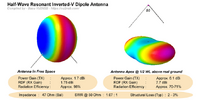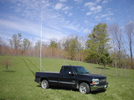My experience with base type antennas is limited to fiberglass verticals, dipoles, and endfeds. I have a steel extendable mast I can mount on my truck to get 30' easily, and I could probably do 40'.
I have an a99, but it seems kinda pointless. I considered making a horizontal dipole so I could get some rejection on the sides to maybe quite some stations a bit. There are plenty of beams obviously, but I don't know that any of them can be broken down or put together in 10 or 15 minutes. A moxon could probably be pretty easy after the initial tuning.
Anyone have any great ideas?
90d Inverted Vee. A fat loaf of French bread radiation signature; quite directional in nature. Very cheep, easy to transport, and very lightweight. I get 1:1 hoisted up and fed at maybe 13'. I hear a lot of traffic but TX is quite limited at 13'. The few reports I have gotten are "sounds good". Neighbor sez I can utilize his pine tree, on property line, but don't have aim and swing perfected to get the 6" rubber doggy donut and line over the lowest 30' limb.
Used 12AWG magnet copper. Bare wire except for thin lacquer coating. 14AWG could have sufficed.
Used 1/2" schedule 40 PVC and joint connector in center as my 11M Vee leg spreader, length
16.58'/2. I figured it'll stick out from 6' truck bed maybe 2'. And I could break the spreader into more section using more joint connectors; perhaps fitting into something resembling long skinny 4.5' duffle bag. I sanded the ends of the PVC that are stuffed into joint connector, for ease of break down. I use paracord to attach antenna legs to spreader.
Insofar as Isolators, unnecessary using paracord and PVC spreader. But should I opt for 1/16" wire rope for longevity:
Fashioned 3/8"W 2"D donuts from ABS sheeting for leg isolator and currently paracord attachment. The 1/4"D x 3/8"W donut through hole is my tuning point/port. The middle disk of three is actually 1.75"D which makes a 1/8" trough around the center of the donut for the paracord, or wire rope, to wrap. All 3 disks are hot-melt glued together. Perhaps later today I'll take a couple pictures of the connection head and balun.
I've a pair of 1.5" U-clamps rigged to support the center, over the center joint connector, should I choose to stabilize it on a mast; though not absolutely necessary unless it's intended for permanent placement and stationary directionality. I was thinking a pair of these antennas, one above the other, I'd have the full horizon nearly covered; and, use an antenna switch, E-W / N-S.
The distance from the feed point and spreader, about 5', is maintained by the coax with lightweight wire ties at the spreader joint connector. Otherwise the 16' PVC pipe spreader will droop. Directionality is maintained by 550 paracord drop lines from the ends of the PVC spreader to ground, straight down if that's all that needed or spread the lines against the winds. I use a pair of the smallest worn out brake disks as anchors. A little unnecessary on the weight, but available when nothing else is.
The length of my spreader is a little longer than necessary for a 90d Vee, if I were motivated towards a 105d Vee, a fatter French loaf; with not quite so focused max power point. Predrilled > attach legs > retune as necessary. The extra length antenna wire is available, with excess wrapped back on itself.
<10 minutes and it's up, likely includes raising the mast.


